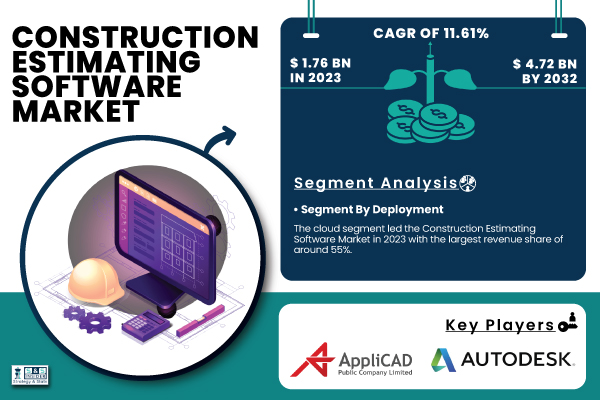Pune, May 05, 2025 (GLOBE NEWSWIRE) — Construction Estimating Software Market Size Analysis:
“The Construction Estimating Software Market, valued at USD 1.76 billion in 2023, is projected to grow to USD 4.72 billion by 2032, with a compound annual growth rate (CAGR) of 11.61% from 2024 to 2032.”

Get a Sample Report of Construction Estimating Software Market@ https://www.snsinsider.com/sample-request/6399
Major Players Analysis Listed in this Report are:
- AppliCad Public Company Limited: [Roof Wizard, RoofScape]
- Autodesk Inc.: [Autodesk Takeoff, Autodesk BIM 360]
- Bluebeam Software Inc.: [Bluebeam Revu, Bluebeam Studio]
- Corecon Technologies, Inc.: [Corecon V8, Corecon Mobile]
- esti-mate: [esti-mate Desktop, esti-mate Online]
- ETAKEOFF, LLC: [eTakeoff Dimension, eTakeoff Bridge]
- Glodon Company Limited: [Glodon TAS, Glodon TRB]
- Microsoft: [Microsoft Dynamics 365 Project Operations, Microsoft Project]
- PlanSwift Software: [PlanSwift Professional, PlanSwift Metric]
- PrioSoft Construction Software: [Contractor’s Office, QuickBooks Integration Module]
- ProEst: [ProEst Cloud, ProEst Mobile]
- RIB Software SE: [RIB iTWO, RIB CostX]
- Sage Group plc: [Sage Estimating, Sage 300 Construction and Real Estate]
- STACK Construction Technologies: [STACK Estimating, STACK Takeoff & Estimating]
- Trimble Inc.: [Trimble Quest, Trimble Accubid]
- Vision InfoSoft (JDM Technology Group): [Electrical Bid Manager, Plumbing Bid Manager]
Construction Estimating Software Market Report Scope:
| Report Attributes | Details |
| Market Size in 2023 | US$ 1.76 Billion |
| Market Size by 2032 | US$ 4.72 Billion |
| CAGR | CAGR of 11.61% From 2024 to 2032 |
| Base Year | 2023 |
| Forecast Period | 2024-2032 |
| Historical Data | 2020-2022 |
| Key Regional Coverage | North America (US, Canada, Mexico), Europe (Eastern Europe [Poland, Romania, Hungary, Turkey, Rest of Eastern Europe] Western Europe [Germany, France, UK, Italy, Spain, Netherlands, Switzerland, Austria, Rest of Western Europe]). Asia Pacific (China, India, Japan, South Korea, Vietnam, Singapore, Australia, Rest of Asia Pacific), Middle East & Africa (Middle East [UAE, Egypt, Saudi Arabia, Qatar, Rest of Middle East], Africa [Nigeria, South Africa, Rest of Africa], Latin America (Brazil, Argentina, Colombia Rest of Latin America) |
| Key Growth Drivers | Growing Infrastructure and Commercial Construction Boosts Demand for Advanced Estimating Software to Enhance Cost Accuracy, Efficiency, and Project Profitability. |
The growth of the market is fueled by the expanding use of digital tools for effective cost estimating, improved project management, and the need for precision and cost control in construction projects. The combination of AI, machine learning, and cloud-based solutions is also making the process of estimating smoother, minimizing human mistakes, and enhancing decision-making. The growth of infrastructure development, especially in emerging markets, and the movement toward automation of the construction process are also the contributing factors for the market’s high growth rate.
The U.S. Construction Estimating Software Market, valued at USD 0.49 billion in 2023, is projected to reach USD 1.31 billion by 2032, growing at a CAGR of 11.45% from 2024 to 2032.
This growth is due to the growing need for precise cost estimation and effective project management in the construction industry. The use of advanced technologies such as AI, machine learning, and cloud-based platforms is improving software capabilities, minimizing errors, and enhancing productivity. Moreover, the growth in construction activities, especially in infrastructure projects, also contributes to market growth.
By Software License, Subscription License Segment Leads the Construction Estimating Software Market, Perpetual License Segment Set for Rapid Growth
The Subscription License segment dominated the Construction Estimating Software Market in 2023, capturing around 59% of the revenue share. This is due to high demand for immediate, cost-effective remedies that require minimal investment initially. They offer scalability & continuous updates & availability due to being cloud-based, making the subscription model a good option for businesses that prefer to have ongoing improvements without that hefty initial investment.
The Perpetual License segment is projected to grow at the fastest CAGR of approximately 13.18% from 2024 to 2032. This is due to the need for long-term cost savings and complete ownership of the software. Large organizations and data security-sensitive companies prefer perpetual licenses since they do not have recurring subscription costs and have complete ownership of the software.
By Deployment, Cloud Segment Dominates the Construction Estimating Software Market, On-Premise Segment Expected to Experience Fastest Growth
The cloud segment led the Construction Estimating Software Market in 2023, capturing around 55% of the revenue share. The dominance of cloud-based solutions is facilitated by the increasing adoption of these solutions owing to their scalability, real-time collaboration options and lower initial capital cost as compared to the on-premise alternatives. Cloud-based software makes it easy for construction companies to access data, work on projects remotely, and keep everything appropriately integrated, all while improving overall operational efficiency and security.
The on-premise segment is projected to grow at the highest CAGR of approximately 12.44% from 2024 to 2032. The demand is growing owing to the deployment nature of companies looking towards investing in estimating software base on keeping crucial data in-controlled environments and reduce risk factors. For instance, organizations that work with sensitive project information opt for on-premise solutions where there is a risk of cybersecurity attacks or where regulatory compliance is necessary.
By Enterprise Size, Large Enterprise Segment Leads the Construction Estimating Software Market
The large enterprise segment dominated the Construction Estimating Software Market in 2023, accounting for around 66% of the revenue share. Large construction manage their large project portfolios with advanced software for budgeting and cost control management. These firms spend on premium products that provide AI-based insights, simultaneous usage, and cloud platforms. Also, adoption by the large scale organizations is fuelled by regulatory compliance requirements, ERP integration and customization requirements.
By End-use, Architects & Builders Segment Leads the Construction Estimating Software Market
The Architects & Builders segment dominated the Construction Estimating Software Market in 2023, accounting for nearly 41% of the revenue share. This is because of the growing demand for accurate cost estimating during the design and planning the building process. Architects and builders use estimating software to choose the most cost-effective materials, assess project feasibility, and align budgets. The introduction of Building Information Modeling (BIM) also increases the precision that reduces the chances of cost-overruns while improving the project execution in large developments.
Do you have any specific queries or need any customization research on Construction Estimating Software Market, Make an Enquiry Now@ https://www.snsinsider.com/enquiry/6399
Construction Estimating Software Market Segmentation:
By Software License
- Perpetual License
- Subscription License
- Others
By Deployment
By Enterprise Size
- Large Enterprise
- Small & Medium Enterprise
By End-use
- Architects & Builders
- Construction Managers
- Contractors
- Others
North America Leads the Construction Estimating Software Market, Asia Pacific Set for Fastest Market Growth
North America dominated the Construction Estimating Software Market in 2023, holding approximately 40% of the revenue share. Its advanced construction industry, high uptake of digital solutions, and prominent presence of large software providers underpin the region’s market leadership. Increased demand for cost-effective project management, incorporation of AI and cloud technology, and stringent regulatory mandates lead to pervasive usage of software. Heavy investment in large-scale infrastructure and smart city development further establishes North America as the market leader.
Asia Pacific is anticipated to grow at the fastest CAGR of about 14.00% from 2024 to 2032. This rapid expansion is driven fueled by urbanization, construction driven by a fast-growing demographic gaining marketable powers and, digital transformation taking place in the business. The increasing government spending on infrastructure development demands the cost estimation software. The growing adoption of cloud-based software, expansion of foreign investments, and increasing awareness about the benefits of automation are some of the major factors boosting the growth of the market in the region.

Table of Contents – Major Key Points
1. Introduction
2. Executive Summary
3. Research Methodology
4. Market Dynamics Impact Analysis
5. Statistical Insights and Trends Reporting
6. Competitive Landscape
7. Construction Estimating Software Market Segmentation, By Software License
8. Construction Estimating Software Market Segmentation, By Deployment
9. Construction Estimating Software Market Segmentation, By Enterprise Size
10. Construction Estimating Software Market Segmentation, By End-use
11. Regional Analysis
12. Company Profiles
13. Use Cases and Best Practices
14. Conclusion
About Us:
SNS Insider is one of the leading market research and consulting agencies that dominates the market research industry globally. Our company’s aim is to give clients the knowledge they require in order to function in changing circumstances. In order to give you current, accurate market data, consumer insights, and opinions so that you can make decisions with confidence, we employ a variety of techniques, including surveys, video talks, and focus groups around the world.
Related Reports:
IT Operations Management Software Market Size By 2032
Corporate Social Responsibility Software Market Forecast by 2032
Camp Management Software Market Share by 2032
Digital Accessibility Software Market Analysis by 2032








